This site contains affiliate links. As an Amazon Associate, I earn a commission from qualifying purchases at no extra cost to you. Full Disclosure Here.
For the past six weeks, I have been exploring alternatives to over-the-counter ointments, salves, and beauty products. Not only are these products expensive, but as I have learned time and time again, they don’t always work.
Starting with a basic formula for healing salve that I found on the internet, I decided to make my own all-purpose salve and to test it on various ailments to see how it worked. I added a bit of this, subtracted a bit of that and came up with I call my own Miracle Healing Salve. The funny thing is that when the final results came in, the formula that worked the best as an all-purpose salve was a version included the same blend essential oils I have been using for muscle aches these past ten plus years. Go figure.
Also Read: Preppers Guide

As easy as this Miracle Healing Salve is to make – and it is easy – it just works. I will share some of the uses that I have become ecstatic about but first, the recipe.
Miracle Healing Salve – The Recipe
Ingredients:
1 Cup Coconut Oil (not fractionated)
1 Cup Extra Virgin Olive Oil
5 Tbl. Organic Beeswax Pastilles
Containers:
8 each – 2 ounce jars or containers **OR**
4 each – 4 ounce mason jars
To each 2 ounce jar add: (double if you are using 4 ounce Mason jars)
5 drops Lavender essential oil
5 drops Rosemary essential oil
5 drops Peppermint essential oil
a few drops of Vitamin E (optional)
1. Put a pot of water on the stove to simmer. While the water is heating, put the coconut oil, olive oil and beeswax pastilles in a heatproof jar or measuring cup.

2. Set the jar filled with the coconut oil, olive oil, and wax into the water and leave it there until it melts, giving it a stir from time to time. You want a slow, gentle melt so take your time. It could take 15 or 20 minutes depending on the temperature of the water bath.

3. While the ingredients are melting, drop your essential oils into each of the containers. Hint: I have found that it is easier to use a glass medicine dropper than the dropper that comes with the bottle of essential oil. This is optional and a matter of personal preference.

4. Pour the melted oils into each of the smaller jars containing essential oils. There is no need to stir unless you want to since the oils will mix up on their own.

5. Cover the jars with a paper towel or cloth and set them aside for up to 24 hours. Although the salve will start to firm up within minutes, it takes at least 12 hours to complete the firming process. (The purpose of the cover is to keep out dust, bugs and other nasties that may be floating around.)

A Word About the Ingredients
Coconut oil is a natural moisturizer and is antibacterial. Olive oil is chock full of antioxidants and has anti-inflammatory properties.
Lavender is a natural antibiotic, antiviral, antifungal and antiseptic. It is a master healer that also helps to prevent scarring. Rosemary is also antiseptic and an excellent treatment for muscle aches. Peppermint is an anti-inflammatory and is also antiseptic. Are you seeing a pattern here?
The optional Vitamin E is an antioxidant and is also used as a natural preservative.
10 Ways (So Far) to Use Miracle Healing Salve
These are the ways I have used this salve with success. I am sure there are others that are yet to be discovered but these make a darn good start!
1. Hand and foot moisturizer: An unbelievably emollient hand and foot moisturizer. No more dry hands and feet.
2. Relief for nocturnal foot and muscle cramps (rub on the bottom of your feet and on your calves before going to bed – this really works!)
3. Eliminates symptoms of eczema and psoriasis: With the addition of 5 to 10 drops of Melaleuca oil (tea tree) to a jar of Miracle Salver, the patch of psoriasis on Shelly’s elbow has all but disappeared. In the past he has tried everything including diet changes and prescription drugs. It has taken about 3 weeks for the Miracle Healing Salve to do its thing. Gone are the ugly crusty patches.
4. Antiseptic Ointment for life’s little bumps and bruises: Instead of Neosporin, reach for Miracle Healing Salve to both soothe and heal cuts and scrapes.
5. Promotes healing of scars: Slather the Miracle Salve over new scars and watch them heal in days rather than weeks. You can barely see the scar from my recent surgery. It is no longer tender, red and angry looking.
6. Makeup Remover: Smear on your face the wipe away your makeup with a damp washcloth.
7. Facial moisturizer and serum: Yes, really. You would think it would be greasy but the oils absorb quickly and leave your face with a nice, dewy texture.
8. Cuticle and nail conditioner: No more ragged cuticles or dry, splitting nails. This is a byproduct of being diligent about #2. It just happened without my realizing it.
8. Hair serum: A few drops liquefied in your palms and then smoothed over your hair will leave it shiny and less fly-away.
10. Relieve pet scratching and itching: Tucker the Dog was scratching himself in one spot on his belly so I put a little Miracle salve on the spot and a couple of days later he stopped. Was it the smell, the healing properties or just a coincidence? I don’t know but it worked.

Items replaced by Miracle Healing Salve
Wild Plant Version of Gaye’s Miracle Healing Salve
By Donna Schott
A number of years back, I found Gaye’s recipe for an essential-oil based DIY Miracle Healing Salve that she found effective on everything from cuts and rashes to sore muscles and eczema. I made the recipe, and have been using it ever since as my go-to first aid salve, replacing Neosporin, Cortisone, aloe vera gel, and other relatively pricey products from the local pharmacy.
In a survival or bug-out situation, however, essential oils may not be available. Once your existing stock runs out, it could easily become difficult or impossible to replace them. That’s why knowing a few common wild medicinal plants can be a life-saver.
A whole array of plants with medicinal qualities grow commonly in yards and urban areas, giving you a surprising bounty of raw material to make your own DIY Miracle Healing Salve even without any essential oils.
Using Common Medicinal Backyard Weeds
To help you be able to make your own medicine regardless of essential oil availability, I’ve re-imagined Gaye’s original recipe with some of these common medicinal backyard weeds. I have listed a number of plants for the ingredients that all have similar healing qualities, so finding and using any combination of them will make a potent salve.
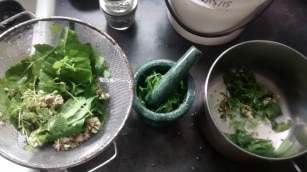
If you’re in a survival situation and don’t have coconut oil, you could make a liquid rub with olive oil or any other fat that is safe to spread onto the skin. You could conceivably even process animal fat for this purpose.
The thing I use this stuff for most is mosquito bites, which I get all over my body in the form of itchy red welts. Mosquitos are a scourge during southern summers, and aside from a momentary cooling sensation, nothing I’ve ever bought at the store seems to help the itch.
After rubbing on a generous amount of this wild plant-based miracle salve, on the other hand, I completely forget about the bites after about five minutes. The itch is erased.
I use it in any of the ways I’d use Gaye’s original healing miracle salve: cuts, scrapes, wounds, boils, rashes, you name it! After giving some of it as a gift, I even got feedback that it helped relieve itching associated with menopause. It’s also pet-safe!
Ingredients:
- 3-4 cups coconut oil
- Half a teaspoon of olive oil infused with vitamin E (optional, but adds nutrients and acts as a preservative)
- 5 tablespoons beeswax
- 1-2 cups slightly crushed medicinal leaves and flowers
Medicinal Plants:
Below is a quick listing of the plants that you can use, with some identifying characteristics and images. Look for these in your yard and around your property, and you’re likely to find many of them just beyond your door. They even grow in parking lots!
For details on the medicinal properties of each of these, take a look at this great resource. I’d expect a salve that used any combination of 2-4 of these plants to be effective, but at the risk of overkill, my version uses them all:
1. Common Plantain Leaves (Plantago major)
Common Plantain has nothing to do with the banana plantains you see in stores. It has tough ovoid leaves with distinctive veins and grows in a basal rosette. Tiny flowers form on a stalk.
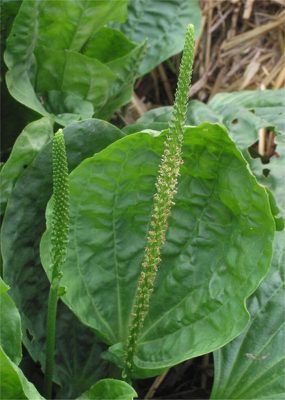
Once a mainstay in native Indian medicine, homeowners from California to Maine now work all spring and summer trying to vanquish this powerful healing plant from their yards.


It is very similar to the common broadleaf variety, except the leaves are lanceolate instead of ovoid.
2. Narrowleaf Plantain Leaves (Plantago lanceolata)
This cousin of the broadleaf plantain has tough, lance-shaped leaves that grow in a basal rosette near disturbed lots, roadsides, and lawns.
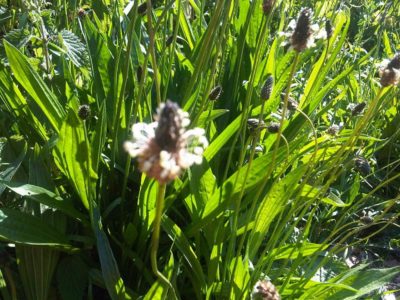

3. Ground Ivy Leaves (Glechoma hederacea)
Ground Ivy is a creeping plant with scalloped leaves and small blue flowers. All parts smell minty when crushed.

The stem is square, not round, and leaves are alternate, meaning the leaf pairs appear in a staggered pattern along the stem.

4. Wood Sorrel Leaves (Oxalis)
Usually mistaken as clovers, wood sorrel leaves have a shamrock-like appearance.
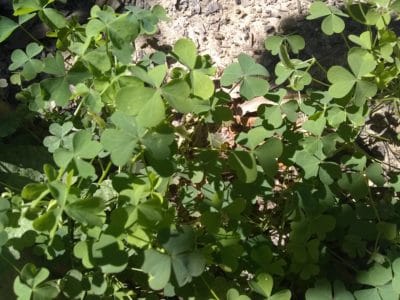
The flowers are small and can be either white, yellow, pink, or purple.

5. Red and White Clover Flowers (Trifolium pratense/Trifolium repens)
For most newbie foragers, this common weed is as easy to identify as a dandelion. The flowers have been prized for centuries for their medicinal qualities.


Step 1: Gather and Crush the Plants
I used about two cups’ worth of total plant material for a liter or so of salve, using approximately equal amounts of each plant with the exception of wood sorrel, which I only used a very small amount of.
You can make a smaller recipe and the amount of plant matter doesn’t have to be precise, just err on the side of too much to ensure your formula is potent enough. Once they are gathered, use a colander to rinse them thoroughly.
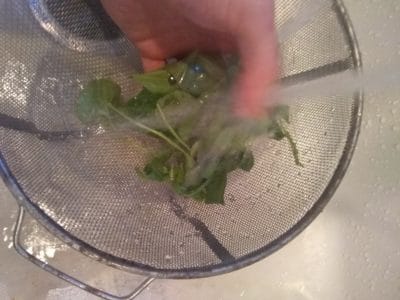
Then use a mortar and pestle or other technique to crush them slightly, just enough so that those membranes are broken and the leaves release a bit of juice.
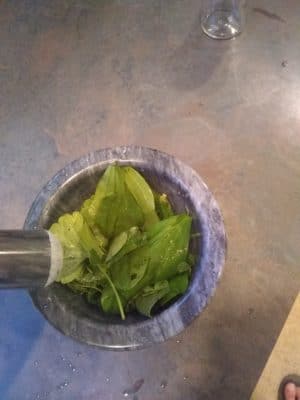
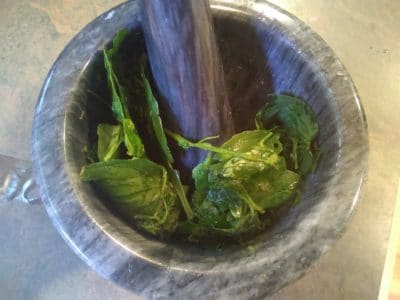
Then I put them into a pot with the coconut oil.
Step 2: Patiently Simmer
Melt the coconut oil at extremely low heat, and make sure you’ve used enough oil that the plant matter is submerged once it melts. Now all you do is simmer, simmer, simmer.
I left mine on for about three hours, but it might be better to leave it on even longer to ease out more of those active chemicals from the plants. The oil should turn a nice green color.

After a few hours or more of simmering, strain the liquid out. There may be some plant matter that finds its way through, which is fine. I didn’t have cheese cloth, but it would have helped to keep some of that extra plant material out of my final product. I like to really try to squeeze the plants to get out as much of the oil as I can.
Step 3: Cool Down
Now just let it cool for about 24 hours. It should keep fresh for a long time – I’d say up to a year or longer in the fridge.
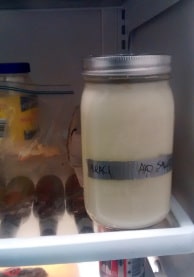
If you’re going to refrigerate yours, just rub your fingers on the salve until the warmth from the friction softens it enough to be applied.
Wild plant-based healing salve is cheaper, fun to make, and is even stronger and more effective (in my experience) than the myriad over-the-counter products it replaces. See what plants you find in your yard, and make a salve that renders store-bought first aid ointments obsolete!
Author Bio: Eric is a nature-loving writer, experience junkie, and former Boy Scout who never forgot that time-honored Scout Motto: Be prepared. Aside from camping and survival, he loves writing about travel, history, and anything he finds strange and unique!
If you enjoyed this article, consider following our Facebook page.
The Final Word
You have not heard the last of this. In addition to this DIY Miracle Healing Salve, I have made batches of Tea Tree Skin Ointment and Lemon Salve. These are themes of the basic formula that were put together to take advantage of the specific properties of oils used in their formulation. I am also experimenting with an infusions of dried oregano and olive oil.
As with all things at Backdoor Survival, I am testing first posting later. Stay tuned!
Enjoy your next adventure through common sense and thoughtful preparation!
Gaye
If you enjoyed this article, consider subscribing to email updates. When you do, you will receive a free, downloadable copy of my e-Book, The Emergency Food Buyer’s Guide.
You can also vote for Backdoor Survival daily at Top Prepper Websites!

Bargain Bin: Here are some links to items used to create your custom-crafted Miracle Healing Salve.
White Plastic Jar with Dome Lid 2 Oz (12 Per Bag): I often chose to use these small ointment jars rather than Mason jars for my salve. I also have similar jars in the 1 ounce size.
Ball Jar Crystal Jelly Jars with Lids and Bands, Quilted, 4-Ounce, Set of 12: Sometimes I use plastic and sometimes I use mason jars. Honestly? It is a matter of personal preference.
Beeswax Organic Pastilles, Yellow, 100% Pure 16 Oz: I ordered the white pastilles but have since learned that the natural yellow pastilles are better. That said, the difference may not be discernable – just be sure that what you purchase is cosmetic grade.
Glass Droppers, Pack of 6: I bought a package of these and loved them. When I went to re-order, I accidentally ordered plastic instead glass droppers. Learn from my mistake. The price is the same go get the glass ones.
Spark Naturals Essential Oils: These is what you need for the Miracle Salve: Lavender essential oil, Rosemary essential oil, and Peppermint essential oil. Enjoy a 10% discount on your Spark Naturals order with code BACKDOORSURVIVAL at checkout.
NOW Foods Essential Oils : My salves were made using essential oils from Spark Naturals. My sniff test tells me they are stronger and more pure smelling. For healing purposes, I feel they are superior. On the other hand, NOW Foods has decent essential oils at a budget price: NOW Foods Rosemary Oil, NOW Foods Peppermint Oil and Now Foods Lavender Oil.
Coconut Oil: Coconut Oil from Tropical Traditions is my preferred coconut oil. I love it so much I purchased a 5 gallon tub. Really, I did! I find it very silky to work with and love the taste when used in cooking. Note that no refrigeration is required and although it solid at room temperature, it melts at 76 degrees. The Nutiva brand from Amazon or Costco works well too.

Kirkland Signature Extra Virgin Olive Oil, 2 Liters (Product of Italy): If you have a Costco close by, get it their. Otherwise, you can use this or any other quality extra virgin olive oil.
The Complete Book of Essential Oils and Aromatherapy: I first became interested in aromatherapy and essential oils in the early 90s which was before they really became mainstream. I read every book I could get my hands on and dabbled at creating synergy’s (a combination of two or more oils that create a chemical compound that is greater than the some of its individual components). My bible then, and even now, is this book.
~~~~~~~~~~~~~~~~~~~~~~~~~~~~~~
~~~~~~~~~~~~~~~~~~~~~~~~~~~~~~
Amazon has a feature called Shop Amazon – Most Wished For Items. This is an easy tool for finding products that people are ‘wishing” for and in this way you know what the top products are. All you need to do is select the category from the left hand side of the screen.
The Amazon Top Most Wished For and Best Selling Outdoor Items
Emergency Preparedness Items from Amazon.com
Shop Amazon Tactical – Great Selection of Optics, Knives, Cases, Equipment
Amazon Gift Cards
Help support Backdoor Survival. Purchases earn a small commission and for that I thank you!
~~~~~~~~~~~~~~~~~~~~~~~~~~~~~~



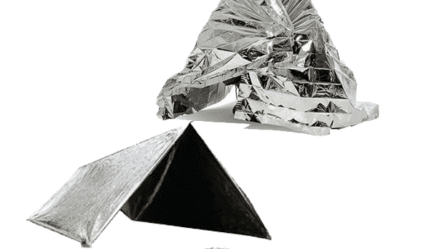






219 Responses to “DIY Miracle Healing Salve”
what can i use as a substitute rosemary oil? Will eucalyptus or tea tree oil work?
The oils you choose really have more to do with the healing qualities you seek than a specific oil. The combination I use (lavender, peppermint, and rosemary) is a great all-around healer.
Instead of rosemary, I would suggest tea tree (Melaleuca). My second choice would be Marjoram but that is just me. If you enjoy eucalyptus and get some benefit from it, then go for it!
No I bought a large bag of pre-grated soy wax….I will try to melt some extra wax and add it to what I have already made and see if it helps…and I will put one in the fridge as well. Thank you and I will try to remember to post an update. And now that I think about it I did add an extra 2 tbl’s of wax when I was melting it to begin with so will have to try some more.
I think I have some soy wax somewhere around here. I will try to make a small batch to see what happens.
Thank you I appreciate you trying to help me figure this out..I am looking forward to using this and seeing how well it works!!!
So I did put one container in the fridge and it did help to set it up, it is solid right now, but i have taken it out of the fridge to see what happens when it gets to room temp. And I took the other 3 containers I made and added 3 tbls of wax to them and they are in the cooling process now. I will post again with the results.
Hi, I just made a batch of this healing salve and it is in the cooling stage but it is not firming at all…..I did make an adjustment and used soy wax because I want to use this on my daughter and I was concerned about the beeswax causing allergy to bees since she is just 14 months. Also I did not use organic coconut oil or olive oil, just the virgin of both. What did I do wrong?
Did you grate the wax yourself? My guess is that you need to increase the amount of wax. That gets tricky because the oils have already been added.
In thinking about it, I would take a small amount of your oil and melt some additional wax. Then, when done, stir this into your salve and see if it firms up. You also might try putting it in the fridge to firm up.
It is definitely not your oils, I have used pure olive oil with no problem.
I’m about to try your salve for the first time and I have a quick question. I’m not especially a fan of coconut oil so I plan to use jojoba oil. Do you think it will make a serious difference?
Not to worry. Coconut oil is often used because of its own healing properties but jojoba, hemp, sweet almond or even 100% Olive Oil will work. I have actually made the 100% olive oil version as a test and it was fine. I ended up using pure olive oil rather than EVOO because the batch I made with EVOO smelled like – duh! – olive oil.
Wow, thanks for the Olive oil heads up, I’ll let you know how it goes!
You might find that you need to increase the amount of beeswax though depending on the consistency you want. I know for me coconut oil is solid the majority of the year (Vermont) so it helps with the firmness. Straight olive or any of the others mentioned, I think, would make it much thinner, something a little more beeswax would compensate for easily. If that matters to you or is what your looking for of course. I don’t know how or if whipping it would change that.
By how much should I up the beeswax?
I have never made it without the coconut oil so I’m not sure, it may be a little trial an error unless you can find a recipe on line but I guess I might start with a couple of tablespoons. You could experiment with a smaller amount or just pour off one container leaving everything “naked” with no EO’s to see how it sets up and then rewarm the rest to either add more beeswax or pour into containers and add EO (if you plan to) if the consistency is right. Whatever you end up making will work and you can just make adjustments with the next batch (or not) too depending on what you want.
Well, I went for it! After reading all the comments I decided to just go for it the second I got the beeswax! Went with the jojoba oil and regular olive oil. I used lavender, rosemary and tea tree oils (what was on hand). Too much beeswax as it all set up to be very solid, more like a lotion bar. I still kind of like it so I’m keeping half and slowly rewarming the rest with more olive oil and castor oil….on a roll!
Wow, this looks great. I have not gotten into essential oils yet, but maybe now is the time.
I thought of one more (possible) use for your oil. I have curly, frizzy hair, and now I swear by Argon Oil of Morocco, applied to damp hair, to make it curl instead of frizz. If this miracle formula worked for that … wow! The money I’d save!
I have kinky, frizzy hair. I have given up on hair serums in favor of coconut oil and patchouli essential oil (a single drop). My hair has never looked better.
(I too, was a huge fan Argon Oil as well as Biosilk. I still have a decent supply of each but use my coconut oil combo instead.)
Hi Gaye,
Love your site and the info you put on it. Thank you!
I made a batch of the MHS and it seems to have come out correctly. When I apply it to my skin it never really absorbs or fades. For instance if I check where I applied it 30 minutes later it’s still an oily patch and looks the same as when I applied it.
I normally allow it your sit a while and then wipe it off. Should the salve absorb into the skin or am I misunderstanding how it should work?
Thank you
Russ – Interesting. It should absorb within 5 or 6 minutes. Do you happen to live in a hot, humid climate? Sorry, but I have to ask if you are rubbing it in. Also, did you follow the recipe exactly or make adjustments.
Oh, here’s a question. Did you use regular coconut oil or the liquid form (fractionated coconut oil). If the latter, that indeed would be a problem. Let me know.
Gaye, thanks for such a fast reply.
I live in eastern PA so yes it does get humid except for winter of course.
The coconut oil I used was Nutiva Organic Virgin CO and the EVOO it was from the local store. I don’t remember the brand but do remember it said “cold pressed”.
I made no adjustments to the recipe (I’m not that creative LOL) and when applying it I rub it in although not for more than a few seconds. Perhaps I need to massage it in longer?
The CO and beeswax were both measured as solids. Not sure if that matters though.
I made the batch a few months ago (same issue when first made) so I’m probably due make a fresh batch. Besides my family thinks dad has gone off the deep end and become a “hippie medicinal nut” so I can have some more fun with them in making some. Wait until they see me making your birch salve 🙂
Regardless of my particular issue I have to say that even though I currently let it sit and then wipe off I do see great results so all’s not lost and I’m really happy I made it.
I believe your nailed it, Russ. You need to massage/rub it in for a minute or so. Try that and see if it disappears from the surface of your skin.
Everything else you did – including the ingredients – are perfectly fine. I have used the Nutiva coconut oil many times myself so I know that is not the problem.
I’ll give that a go then and see if it makes a difference. Like I said I’m going to make another fresh batch soon so I’ll be extra careful in my measurements also just in case I goofed last time.
Much thanks for your help.
Sorry to butt in but I had a similar experience with the salve I made with EVOO too. I tried substituting Avocado Oil for the EVOO with the next batch (I also made 1/2 a batch as I was experimenting) and found that that absorbed much better and didn’t stay feeling as greasy as I found the original recipe to be, for me. Not everyone seems to have this same problem and I don’t know why I do but I tried the avocado oil (I used a high quality cold pressed, I believe, oil I actually found at Costco after comparing several) because I read that it had properties closer to our own skin/body chemistry, was very good for the skin and I figured that might mean it would absorb well. Everything else I used was the same and it definitely absorbs better and just feels better. It doesn’t take as long for me to feel comfortable touching things when I rub some on my hands, I’m guessing you know exactly what I mean if you have had the same problem. It does help to rub it in as well of course but that just doesn’t seem to take as long. Also, a little goes a long way, that goes for both salves I think. I have to say I was disappointed when I made the first batch because I wanted to like it so much but was thinking it just wasn’t going to work for me until I tried subbing in the avocado oil.
Hi Gaye,
My mother suffers from severe muscle asches and spinal disc herniation. Will this salve help? Do you have any advice on what can be done?
I love your site!
Mahad
I would crank things up a notch (actually a lot of notches) and use my birch salve. It has worked miracles on my husband’s arthritis pain. (It actually uses more than just Birch essential oil but it is the birch that we started with and kept adding until we receive optimal results.)
Here is a link: //www.backdoorsurvival.com/birch-essential-oil-for-arthritis-muscle-and-joint-pain/
Don’t forget to let the mixture cool for a few minutes before you put the essential oils in. Heat kills some of the healing properties of the oils.
Hi Gaye, Its nice to see another PNW prepper. Thank you so much for all the wonderful info you have given us. A few questions I am hoping you might be able to answer for me or someone reading this, maybe I can figure it out. I made the salve as directed with addition of shea butter, but the oil amounts all still equaled the same. Meaning it was still 2 cups worth. It has had a hard time setting up as well as I would like for a salve, but I am also using beeswax sheets that were gifted to me. I am thinking that I need to put it all back into a pot and add more wax on low heat? But if I do that, will I reduce the medicinal value of the oils? Also, after reading some of the readers suggestions, I was curoius about what might happen if I add Turmeric in the power form (since that is the ony way I currently have it). I read that if a salve is too oily, to add cornstarch and I am wondering if it would work in the same manner and also give the healing of the herb. Last question and I apologize for such a lengthy post, but I also happen to have Frankincense in the resin form. I am wondering if I can add that also and have it melt with the oils? Any thoughts on this would be ever so helpful.. thank you so much!
Hi Victoria, I’m not as experienced as Gaye and I know you are asking her but since she is usually so quick to respond to peoples questions and I don’t see one here I’m thinking maybe she hasn’t seen your post or something since the original chain is older. I figured I would give you my 2 cents while your waiting for her to see it. First on the sheets of beeswax you used, there are two possibilities, one being that they might be for candle making and aren’t 100% pure beeswax (sometimes candle making supplies have other things mixed in), the other more likely issue is that the measurement is a little off being that you used sheets instead of the granules she is using, I know 1T of shavings comes out differently that 1T granules for instance. So your plan to add some more beeswax is probably a good one but it will be a bit of trial and error so maybe use say 2oz of your mixture to figure out what works best before changing all of it. That way if you don’t add enough extra beeswax you can try and if you add too much you know before doing it to the whole batch. Does that make sense? It got more confusing as it came out than it sounded in my head… 😉 Low heat in a water bath shouldn’t be hot enough to hurt the EO’s, just be patient and keep an eye on it. On the turmeric, I am anxious to try adding some as well but I’m thinking that adding the powder directly to a salve blend may not be the most effective way. First I’m thinking it may stain everything it comes in contact with skin, hands, fabric and I don’t know if the powder form not having been infused in one of the oils will even absorb into the body to offer it’s benefits. I may be wrong about this too but it seems to me that infusing either the root or maybe the powder into the olive oil and then straining it so there aren’t any undissolved particles left might be more effective. The other option that sounds promising is simply adding Turmeric oil providing it has all of the same properties (I had no idea it existed before reading about it here). I plan on doing some research about the oil to see how it compares to the other forms myself. But from using the powder in cooking I know it doesn’t dissolve well and stains everything. I don’t know about using the Frank resin but it’s worth researching a bit, Frankincense is such a wonderful substance and I know the resin is expensive so I wouldn’t want you to waste it too much by experimenting blindly. The concoction your making sure does sound fantastic and very beneficial though, good luck!
Thanks for filling in Gwyn. To be perfectly honest, I get about 300 emails a day and it is impossible for me to respond to every single one. I don’t mean to snub, but the reality is that the time it takes would be overwhelming. (It already is but that is another story).
I have been working with infused oil with my Cayenne salve and will be writing about it soon. The cayenne does not dissolve in the oil and must be strained through cheesecloth. I strained mine once but should have repeated the process since there are still granules in my salve. The salve is reddish in color but does not appear to stain. OTOH, I don’t feel any healing properties myself so I am continuing my testing process.
I have no reason to believe that Turmeric would be any different.
Hope this helps and please, add your two cents any time. It really helps me out more than you can know.
I wonder if using actual chili peppers to infuse the oil seeds and all might be better than using the powder for getting the full properties into the oil. Same idea as I was suggesting with the turmeric root rather than powder. I’ll be very curious to hear what you find. Thanks for letting me off the hook, I’m glad it was clear I was just trying to help (both of you) 😉
T
Thanks very much for your prompt response. I will try your suggestion as I have those EOs on hand. I’m thankful to have discovered your wonderful website!